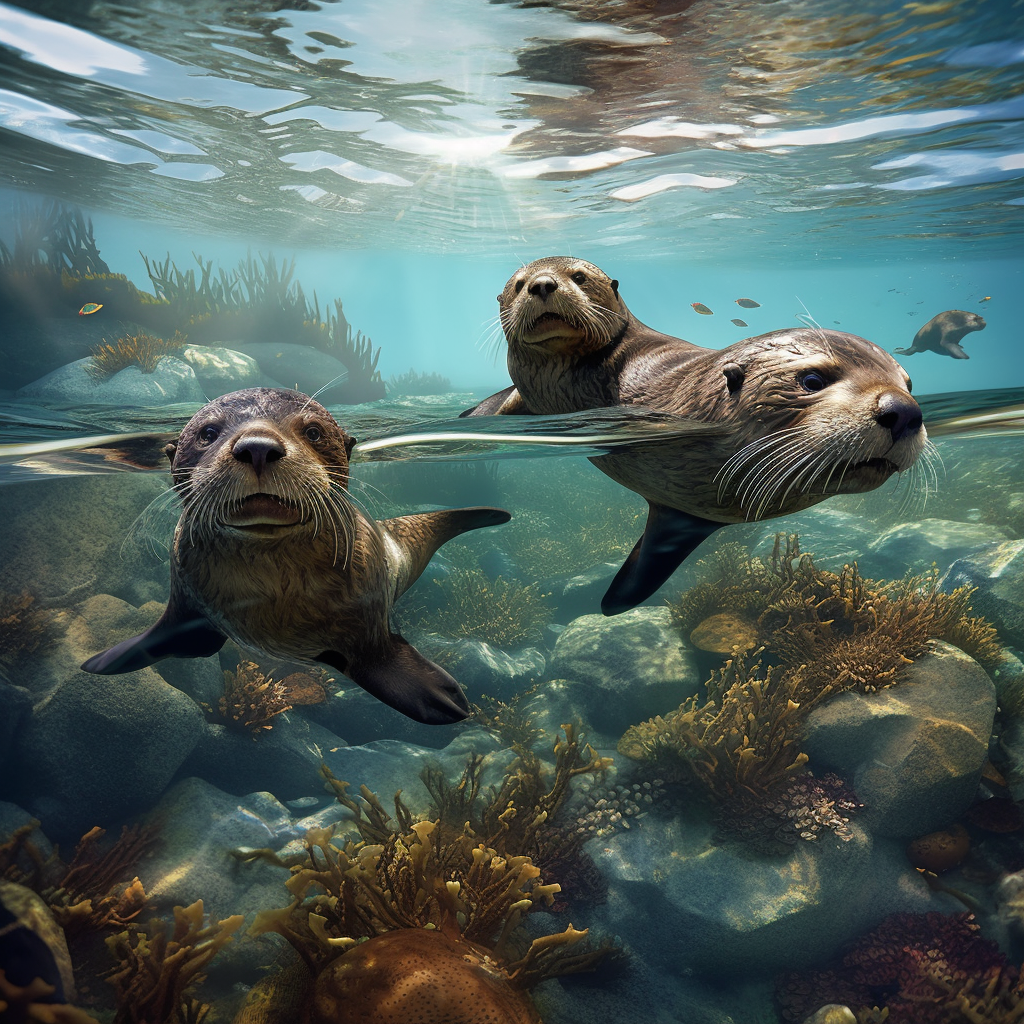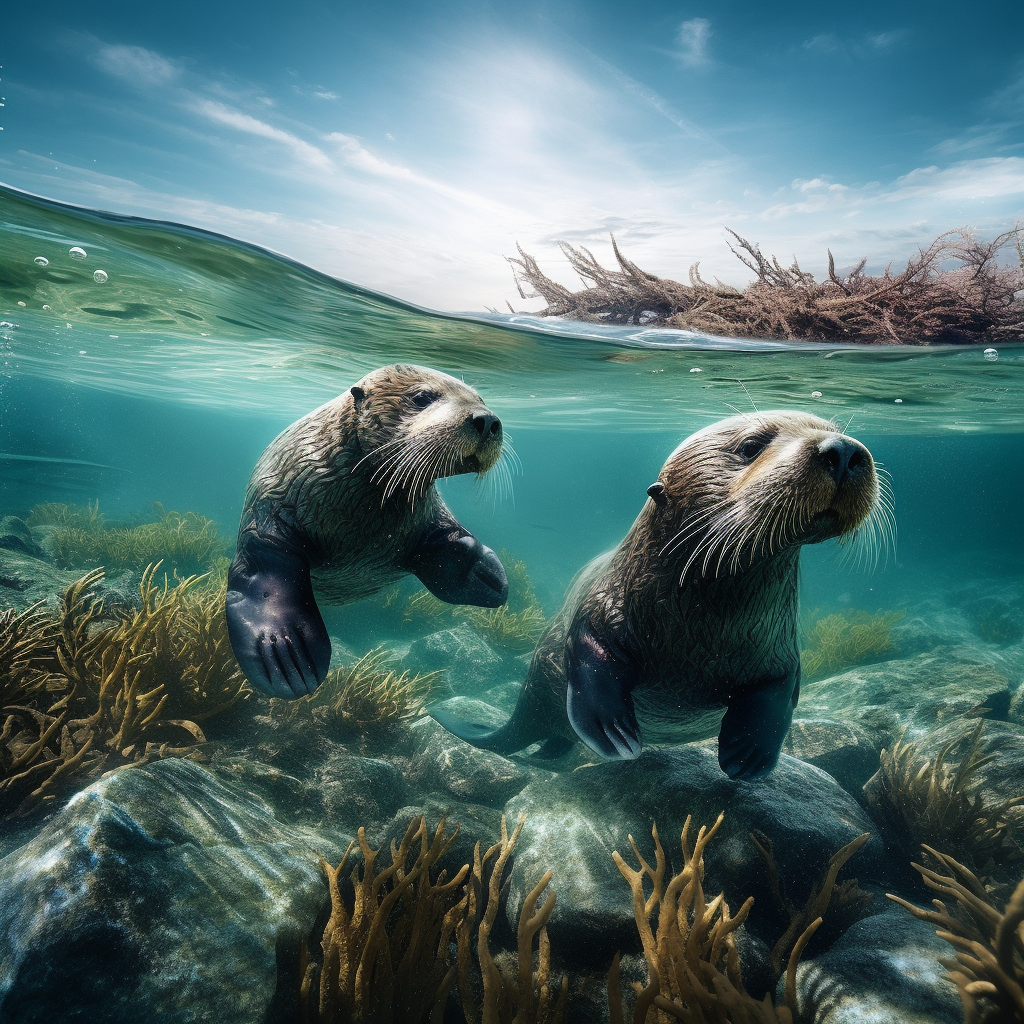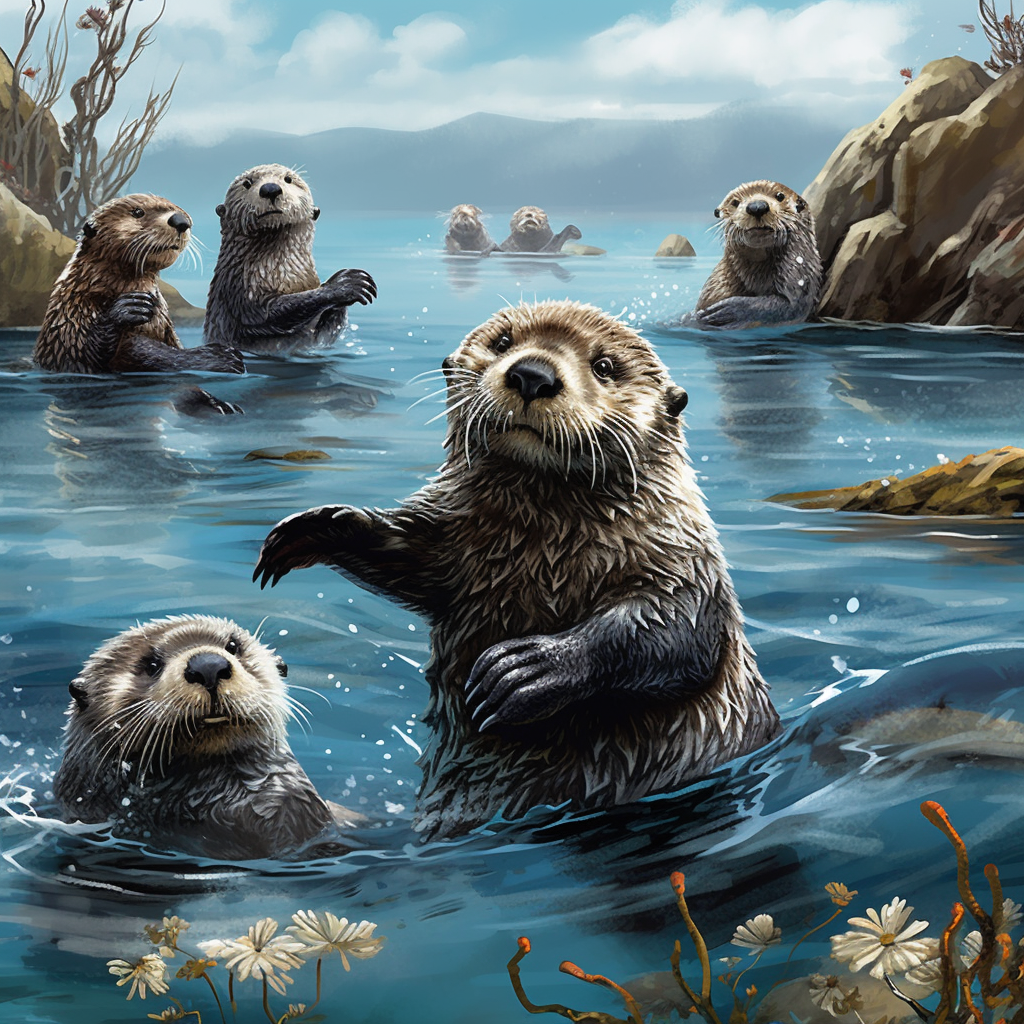Sea otters are fascinating creatures that inhabit coastal waters and are known for their playful behavior and adorable appearance. However, many people wonder if these seemingly harmless animals can be dangerous. In this article, we will explore the question, “Are sea otters dangerous?” and delve into the behaviors and characteristics of these marine mammals to gain a better understanding of their potential risks. We will also discuss any instances where sea otters have been known to pose a threat to humans or other animals. So, let’s dive in and uncover the truth about the safety of interacting with sea otters.
Key Takeaways
- Sea otters are not typically dangerous to humans.
- They are known for their playful and curious nature.
- However, it is important to maintain a safe distance and not disturb or approach them in the wild.
- Like any wild animal, sea otters can become aggressive if they feel threatened or provoked.
- It is crucial to respect their natural habitat and observe them from a responsible distance.
Understanding Sea Otters: A Brief Overview

Sea otters are fascinating creatures that inhabit coastal waters and are known for their playful behavior and adorable appearance. In this section, we will delve into the unique characteristics of sea otters and explore their habitat and lifestyle.
A. The Sea Otter: A Unique Marine Mammal
Sea otters (Enhydra lutris) are the largest members of the weasel family and are well-adapted to life in the water. They have a sleek, streamlined body, with dense fur that helps them stay warm in the chilly ocean. In fact, sea otters have the thickest fur of any mammal, with up to one million hairs per square inch!
These marine mammals are found along the coasts of the northern Pacific Ocean, from Alaska to California, and also in parts of Russia and Japan. Sea otters are highly social animals and can often be seen floating on their backs, using their paws to groom their fur or crack open shellfish.
One interesting fact about sea otters is that they do not have a layer of blubber like other marine mammals. Instead, they rely on their dense fur and a high metabolic rate to keep warm in the cold ocean waters. This means that they spend a significant amount of time grooming their fur to keep it clean and well-insulated.
B. The Habitat and Lifestyle of Sea Otters
Sea otters are primarily found in nearshore habitats, such as kelp forests, rocky shores, and estuaries. These areas provide them with a rich food source and protection from predators. Kelp forests, in particular, are crucial for sea otters as they provide a safe haven where they can rest, forage, and raise their young.
Sea otters are known for their remarkable diving abilities. They can dive up to 300 feet in search of food, such as sea urchins, crabs, clams, and other marine invertebrates. Their diet mainly consists of shellfish, and they are often seen using rocks or other hard objects to crack open their prey.
When it comes to reproduction, sea otters have a unique mating system. Females give birth to a single pup, which they care for intensively. The mother otter will nurse and groom her pup, teaching it essential survival skills. Sea otter pups are incredibly adorable, but it’s important to remember that they are wild animals and should not be approached or disturbed.
In conclusion, sea otters are fascinating creatures that play a vital role in coastal ecosystems. While they may appear harmless and cute, it’s crucial to respect their wild nature and observe them from a safe distance. By understanding their unique characteristics and habitat, we can appreciate these remarkable marine mammals and contribute to their conservation efforts.
Are Sea Otters Dangerous to Humans?
Sea otters are fascinating creatures that inhabit coastal waters and are known for their playful behavior and adorable appearance. However, there is a common question that often arises: are sea otters dangerous to humans? In this section, we will explore instances of sea otter aggression towards humans and debunk the misconception of sea otters as pets.
A. Instances of Sea Otter Aggression Towards Humans
Sea otters are generally gentle and non-aggressive animals, but like any wild animal, they can become defensive if they feel threatened or cornered. Instances of sea otter aggression towards humans are extremely rare and usually occur when people try to get too close to them or disturb them in their natural habitat.
It’s important to note that sea otters are protected under the Marine Mammal Protection Act, which prohibits any form of harassment or disturbance to these animals. Interacting with sea otters in the wild should always be done from a safe distance to ensure both human and otter safety.
B. The Misconception of Sea Otters as Pets
Sea otters may look adorable and cuddly, but they are not suitable pets. Keeping a sea otter as a pet is not only illegal but also poses significant risks to both the otter and the owner. Sea otters are wild animals with specific dietary and habitat requirements that cannot be met in a domestic setting.
Sea otters have powerful jaws and sharp teeth, which they use to crack open shellfish and other prey. While they rarely bite humans, their bites can cause serious injuries. Additionally, sea otters have strong claws that they use for grooming and manipulating objects. A playful scratch from a sea otter can also result in harm.
Moreover, sea otters are highly social animals that thrive in the company of their own kind. Keeping a sea otter as a pet deprives them of their natural social interactions and can lead to psychological distress. It is essential to respect the natural behavior and habitat of sea otters and appreciate them from a safe distance.
In conclusion, while sea otters are not inherently dangerous to humans, it is crucial to exercise caution and respect their wild nature. Interactions with sea otters should be limited to observing them in their natural habitat and ensuring the safety and well-being of both humans and these remarkable marine mammals.
The Danger Sea Otters Pose to Other Animals
Sea otters are adorable creatures that inhabit coastal waters, but beneath their cute and cuddly appearance lies a predatory nature that can pose a danger to other animals. Let’s explore the impact sea otters have on marine ecosystems and their role as hunters in the wild.
A. Sea Otters and Their Predatory Nature
Sea otters are skilled hunters and have a diverse diet that primarily consists of marine invertebrates such as sea urchins, crabs, clams, and abalone. They use their dexterous paws to search for food on the ocean floor, often flipping rocks and using tools to crack open shells. While they may look harmless, sea otters are capable of inflicting serious bites and scratches if threatened or cornered.
It’s important to note that sea otter attacks on humans are extremely rare. These animals are generally not aggressive towards people and tend to avoid human interaction. However, it’s crucial to respect their wild nature and keep a safe distance if you encounter one in the wild. Trying to get too close or attempting to pet a sea otter can result in bites or scratches, as they may perceive it as a threat.
B. The Impact of Sea Otters on Marine Ecosystems
Sea otters play a vital role in maintaining the balance of marine ecosystems. By preying on herbivorous invertebrates like sea urchins, they help control their population and prevent overgrazing of kelp forests. This, in turn, allows kelp forests to thrive and provides habitat for a diverse range of marine species.
However, the absence of sea otters can have detrimental effects on marine ecosystems. Without their presence, sea urchin populations can explode, leading to the decimation of kelp forests. This loss of habitat can negatively impact numerous species that rely on kelp for food and shelter, including fish, crustaceans, and other invertebrates.
Conservation efforts are crucial to protect sea otters and ensure the health of marine ecosystems. The decline in sea otter populations due to historical fur trade and habitat loss has led to their classification as a threatened species. By implementing measures to safeguard their habitats and promoting responsible human-otter interactions, we can help preserve these fascinating creatures and the delicate balance of our oceans.
In conclusion, while sea otters may appear harmless and cute, they possess a predatory nature that can be dangerous to other animals. Their role as hunters in the wild is essential for maintaining healthy marine ecosystems. By understanding and respecting their behavior, we can coexist with these remarkable creatures and contribute to their conservation.
Are Sea Otters Deadly?

Sea otters are fascinating creatures that inhabit coastal waters and are known for their playful behavior and adorable appearance. However, there is a common misconception that sea otters are dangerous and potentially deadly. In this section, we will explore the defensive mechanisms of sea otters and debunk the myth surrounding their alleged toxicity.
A. The Defensive Mechanisms of Sea Otters
Sea otters have several natural defense mechanisms that they employ when they feel threatened. These mechanisms help them ward off potential predators and ensure their survival in the wild. Here are some of the ways sea otters defend themselves:
-
Biting: Sea otters have sharp teeth that they can use to bite if they feel cornered or in danger. However, it is important to note that sea otters rarely bite humans unless provoked or startled. In general, they prefer to avoid confrontation and will only resort to biting as a last resort.
-
Scratching: Sea otters have strong claws that they use for grooming and foraging. While these claws can cause scratches, they are not typically harmful to humans. In fact, sea otters are known to be gentle creatures and rarely pose a threat to people.
-
Escape: Sea otters are excellent swimmers and can quickly escape from potential threats by diving into the water. Their streamlined bodies and webbed feet allow them to navigate through the ocean with ease, making it difficult for predators to catch them.
-
Vocalizations: Sea otters use a variety of vocalizations, including growls, hisses, and whistles, to communicate with each other and deter potential threats. These vocalizations serve as a warning to predators and can help scare them away.
B. Debunking the Myth: Are Sea Otters Poisonous?
There is a common myth that sea otters are poisonous, but this is entirely false. Sea otters do not possess any toxic substances or venom that could harm humans or other animals. This misconception may have originated from the fact that sea otters consume a diet primarily consisting of shellfish, such as clams, mussels, and crabs.
While it is true that some shellfish can be toxic to humans if consumed in large quantities or if they contain harmful bacteria, sea otters have developed a resistance to these toxins. They have a specialized liver enzyme that allows them to safely consume shellfish without experiencing any ill effects.
In fact, sea otters play a crucial role in maintaining the health of coastal ecosystems. By feeding on shellfish, they help control their populations and prevent overgrowth, which can have detrimental effects on the ecosystem.
In conclusion, sea otters are not deadly creatures. While they do have natural defense mechanisms, such as biting and scratching, they rarely pose a threat to humans. The myth surrounding their alleged toxicity is unfounded, as sea otters are not poisonous in any way. It is important to appreciate these remarkable animals for their unique characteristics and their important role in the marine ecosystem.
The Threats Facing Sea Otters
Sea otters, known for their playful nature and adorable appearance, face numerous threats that endanger their survival. In this section, we will explore why sea otters are endangered, the dangers they face in their natural habitat, and the role of whales in their survival.
A. Why Sea Otters are Endangered
Sea otters are classified as an endangered species, primarily due to historical overhunting for their fur. In the 18th and 19th centuries, sea otters were hunted extensively for their luxurious pelts, which led to a significant decline in their population. Fortunately, conservation efforts have helped in their recovery, but they still face ongoing challenges.
One of the main reasons sea otters remain endangered is the degradation of their habitat. Pollution, coastal development, and climate change have all taken a toll on the ecosystems where sea otters reside. These factors can lead to reduced food availability, habitat loss, and increased vulnerability to diseases.
B. The Dangers Sea Otters Face in Their Natural Habitat
Sea otters face several dangers in their natural habitat, including predation, disease, and competition for resources. While sea otters are not inherently dangerous to humans, they can exhibit defensive behaviors if they feel threatened or cornered. However, such instances are rare, and sea otters generally avoid human interaction.
Predation is a significant threat to sea otters, especially from larger marine predators such as sharks and killer whales. These predators see sea otters as a potential food source and may attack them. Additionally, sea otters can be vulnerable to diseases and parasites, which can weaken their immune systems and impact their overall health.
Competition for resources, particularly food, is another challenge sea otters face. As their population recovers, sea otters must compete with other marine species for limited food sources. This competition can lead to food scarcity, affecting the otters’ ability to thrive and reproduce.
C. The Role of Whales in Sea Otters’ Survival
Whales play a crucial role in the survival of sea otters. Specifically, killer whales, also known as orcas, have a significant impact on sea otter populations. While orcas are apex predators and pose a threat to sea otters, they also indirectly benefit them.
Orcas primarily prey on sea otters by targeting them in shallow waters. This predation pressure has led sea otters to seek refuge in kelp forests, where they can find protection from orcas. Kelp forests provide a safe haven for sea otters, as the dense vegetation helps conceal them from their predators.
Furthermore, the presence of sea otters in kelp forests has a positive impact on the ecosystem as a whole. Sea otters feed on sea urchins, which are known to overgraze kelp forests. By controlling the sea urchin population, sea otters help maintain the health and biodiversity of the kelp forest ecosystem.
In conclusion, sea otters face numerous threats that endanger their survival. Historical overhunting, habitat degradation, predation, disease, and competition for resources all contribute to their endangered status. However, conservation efforts and the understanding of their ecological role are crucial in ensuring the long-term survival of these charismatic marine mammals.
The Protection Status of Sea Otters
Sea otters are fascinating creatures that play a vital role in the marine ecosystem. They are known for their adorable appearance and playful behavior, but are sea otters protected species? Let’s explore the protection status of sea otters and the conservation efforts in place to safeguard their populations.
A. Are Sea Otters Protected Species?
Sea otters are indeed protected species due to their vulnerability and importance in maintaining the balance of coastal ecosystems. In the United States, they are protected under the Marine Mammal Protection Act (MMPA) and the Endangered Species Act (ESA). These acts prohibit the hunting, harassment, and disturbance of sea otters, ensuring their survival and well-being.
The MMPA, enacted in 1972, protects all marine mammals in U.S. waters, including sea otters. It prohibits the capture, killing, or harassment of these animals and establishes guidelines for their conservation. The ESA, on the other hand, designates sea otters as a threatened species, providing additional protection and conservation measures.
B. Conservation Efforts for Sea Otter Populations
Conservation efforts are crucial to safeguard the populations of sea otters and ensure their long-term survival. Various organizations and government agencies are actively involved in protecting these charismatic creatures. Here are some of the conservation efforts in place:
-
Habitat Protection: Preserving the natural habitats of sea otters is essential for their survival. Efforts are made to protect coastal areas, such as kelp forests and estuaries, which serve as important habitats for sea otters and provide them with food and shelter.
-
Population Monitoring: Regular monitoring of sea otter populations helps scientists and conservationists understand their numbers, distribution, and health. This information is vital for implementing effective conservation strategies and identifying potential threats.
-
Rescue and Rehabilitation: Injured or stranded sea otters are often rescued and rehabilitated by specialized organizations. These efforts aim to treat injured otters, release them back into the wild, and raise awareness about the importance of protecting these animals.
-
Public Education: Educating the public about sea otters and their conservation is crucial for fostering a sense of responsibility and promoting their protection. Awareness campaigns, educational programs, and outreach initiatives help raise awareness about the importance of preserving sea otter populations.
-
International Cooperation: Sea otters are not limited to the United States; they also inhabit other regions, such as Canada and Russia. International cooperation and collaboration are essential for protecting sea otters across their entire range and ensuring their conservation on a global scale.
By implementing these conservation efforts, we can help protect sea otters and ensure their populations thrive. It is important to remember that while sea otters are generally harmless to humans, it is crucial to respect their natural behavior and maintain a safe distance to avoid any potential disturbance or harm to both the otters and ourselves.
In the next section, we will explore the threats faced by sea otters and the impact they have on the marine ecosystem. Stay tuned to learn more about these fascinating creatures and their role in the coastal environment.
The Giant Sea Otter: A Special Case

A. Are Giant Sea Otters More Dangerous?
When discussing the potential danger of sea otters, it’s important to note that the giant sea otter, also known as the southern sea otter or the South American sea otter, is a distinct species from the common sea otter. While both species belong to the otter family, they have some differences in behavior and size.
Giant sea otters are larger than their common counterparts, with males weighing up to 100 pounds and measuring around 6 feet in length. This size difference has led some to wonder if giant sea otters are more dangerous than common sea otters.
However, it’s essential to understand that sea otters, regardless of their species, are not inherently dangerous to humans. They are generally peaceful and prefer to avoid confrontation. Sea otters are primarily known for their playful nature and their ability to coexist peacefully with other marine creatures.
While it is true that sea otters have sharp teeth and strong jaws, they rarely use them aggressively towards humans. Instances of sea otter bites or attacks on humans are extremely rare and usually occur when the animal feels threatened or cornered. In most cases, sea otters will try to escape or keep their distance from humans rather than engage in aggressive behavior.
B. The Struggle of Giant Sea Otters for Survival
The giant sea otter faces numerous challenges in its struggle for survival. These challenges include habitat loss, pollution, climate change, and overfishing. As a result, the population of giant sea otters has significantly declined over the years, making them an endangered species.
Habitat loss is a significant threat to giant sea otters. Coastal development and human activities have led to the destruction of their natural habitats, including kelp forests and estuaries. Without these habitats, giant sea otters struggle to find suitable food sources and shelter, further endangering their survival.
Pollution, such as oil spills and chemical runoff, also poses a significant threat to giant sea otters. These pollutants can contaminate their food sources and disrupt their reproductive cycles. Additionally, pollution can weaken the otters’ immune systems, making them more susceptible to diseases.
Climate change is another pressing issue for giant sea otters. Rising sea temperatures and ocean acidification can negatively impact the availability of food sources, such as shellfish and sea urchins. These changes in the ecosystem can lead to malnutrition and starvation among giant sea otters.
Overfishing is yet another threat to the survival of giant sea otters. As humans deplete fish populations, otters must compete for limited resources. This competition for food can lead to nutritional stress and a decline in the overall health of the otter population.
In conclusion, while giant sea otters are not inherently more dangerous than common sea otters, they face numerous challenges in their struggle for survival. The destruction of their habitats, pollution, climate change, and overfishing all contribute to the decline of the giant sea otter population. It is crucial that we take steps to protect and conserve these magnificent creatures to ensure their continued existence in our oceans.
Are Sea Otters in Danger of Extinction?
A. The Current Status of Sea Otter Populations
Sea otters, known for their adorable appearance and playful behavior, are an important part of marine ecosystems. However, their populations have faced significant challenges over the years, leading to concerns about their future. Let’s take a closer look at the current status of sea otter populations.
-
Historical Decline: Sea otters were once abundant along the coasts of the North Pacific Ocean, from Japan to California. However, due to extensive hunting for their fur in the 18th and 19th centuries, their numbers plummeted. By the early 20th century, sea otters were on the brink of extinction.
-
Conservation Efforts: Thankfully, conservation efforts have helped sea otter populations recover in some areas. The International Union for Conservation of Nature (IUCN) lists the sea otter as an endangered species, but their numbers have shown signs of improvement in certain regions.
-
Population Distribution: Sea otters are primarily found along the coasts of Alaska, British Columbia, Washington, and California. These areas provide suitable habitats with abundant food sources, such as sea urchins, clams, and crabs.
-
Population Growth: Despite the positive trends in some regions, sea otter populations continue to face challenges. Factors like oil spills, pollution, habitat degradation, and predation by sharks and killer whales can impact their numbers.
-
Threats to Recovery: In addition to natural threats, human activities also pose risks to sea otters. Pollution from industrial and agricultural sources can contaminate their habitats, while entanglement in fishing gear can lead to injury or death. These threats hinder the recovery of sea otter populations.
B. The Future of Sea Otters: Predictions and Concerns
Looking ahead, the future of sea otters remains uncertain. While conservation efforts have made a positive impact, there are still concerns about their long-term survival. Here are some predictions and concerns regarding the future of sea otters:
-
Climate Change: Sea otters rely on kelp forests for shelter and protection. However, rising ocean temperatures and changes in ocean chemistry due to climate change can negatively affect kelp forests. This loss of habitat could have a significant impact on sea otter populations.
-
Disease and Parasites: Sea otters are susceptible to various diseases and parasites, including Toxoplasma gondii and the sea otter encephalitis virus. These health issues can weaken individuals and potentially lead to population declines.
-
Predation: While sea otters are skilled swimmers, they face predation from larger marine predators. Killer whales, in particular, are known to prey on sea otters. As killer whale populations increase, the risk to sea otters also rises.
-
Human-otter Interaction: As sea otter populations recover, there is an increased likelihood of human-otter interactions. While sea otters are generally not aggressive towards humans, they can become habituated to human presence, which can lead to conflicts and potential harm to both humans and otters.
-
Continued Conservation Efforts: To ensure the long-term survival of sea otters, ongoing conservation efforts are crucial. This includes protecting their habitats, reducing pollution, implementing sustainable fishing practices, and raising awareness about the importance of sea otters in marine ecosystems.
In conclusion, while sea otter populations have shown signs of recovery in certain regions, they still face numerous challenges. Climate change, disease, predation, and human activities all pose threats to their future. By continuing to prioritize conservation efforts, we can help protect these charismatic creatures and ensure their place in our oceans for generations to come.
Conclusion
In conclusion, while sea otters may appear cute and harmless, they can actually be quite dangerous if provoked or threatened. Their sharp teeth and strong jaws allow them to defend themselves against predators and even humans. However, it’s important to note that sea otters are generally not aggressive towards humans and will only attack if they feel threatened or cornered. It is crucial to respect their space and observe them from a safe distance when encountering them in the wild. Despite their potential for danger, sea otters play a vital role in maintaining the health of marine ecosystems and are a protected species. So, while they may be capable of causing harm, it is our responsibility to coexist with these fascinating creatures and appreciate them from afar.
Frequently Asked Questions
Are sea otters friendly to humans?
While sea otters are generally not aggressive towards humans, they are wild animals and can be unpredictable. It’s important to remember that human-otter interactions should be kept to a minimum to ensure the safety of both parties.
Why are sea otters endangered?
Sea otters are endangered due to a variety of factors. These include oil spills, which can damage their fur and cause hypothermia, as well as predation, disease, and habitat degradation. Additionally, they were heavily hunted in the past for their fur.
Are sea otters deadly?
While sea otters are not typically deadly to humans, they can be dangerous if they feel threatened. Otter attacks, though rare, can result in serious injuries due to their sharp teeth and strong jaws.
Are sea otters dangerous to other animals?
Sea otters are predators and can be dangerous to the animals they prey on, which include sea urchins, crabs, and various species of shellfish. However, they play a crucial role in maintaining the balance of their ecosystem.
Are sea otters protected?
Yes, sea otters are protected under the Endangered Species Act and the Marine Mammal Protection Act in the United States. These laws make it illegal to harm, harass, or kill sea otters.
What dangers are sea otters facing?
Sea otters face a variety of dangers including oil spills, pollution, climate change, and habitat loss. They are also at risk from predation by sharks and killer whales.
Are giant sea otters dangerous?
Giant sea otters, like all otters, can be dangerous if they feel threatened. However, they are generally not a threat to humans unless provoked.
How are sea otters dangerous?
Sea otters can be dangerous due to their sharp teeth and strong jaws. If they feel threatened, they may bite or scratch, which can result in serious injury.
Are sea otters in danger of extinction?
While sea otters are currently listed as endangered, conservation efforts have helped to increase their population in recent years. However, they still face many threats and are considered at risk of extinction.
Are sea otters poisonous?
No, sea otters are not poisonous. They do not possess any venomous or toxic substances. However, their bites can lead to serious infections if not treated properly.




